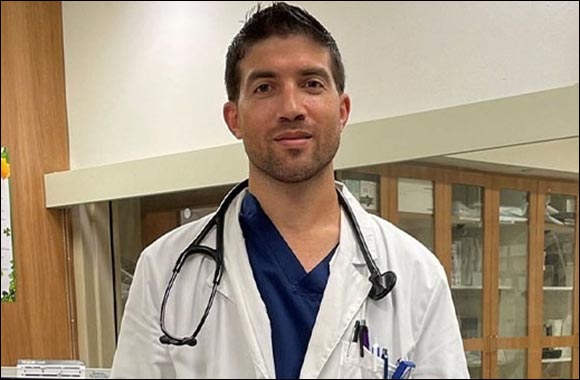
St. George's University School of Medicine Graduate Helps Perform World-First Robotic Heart Procedure in Outpatient Facility
Dr. Adam Bierzynski was on the team that performed the first-ever outpatient robotic percutaneous coronary intervention. He reveals why the procedure was groundbreaking, the potential life-saving capabilities of robotics within the field of cardiology, his experience at St. George’s University, and how his medical training set him up for success.
“I wanted to be a doctor for most of my life,” says Dr. Adam Bierzynski, alumni of St. George’s University (SGU), School of medicine in Grenada.
“My grandfather was the chief medical officer of Grenada for a time, and I was always interested in the sciences and being able to apply knowledge to helping and healing,” he adds.
After being raised and completing high school in Grenada, in the Carribean, he started the 4-Year Medical Degree Program at SGU in 2007 – a time he remembers fondly.
“Attending SGU was a fantastic experience. The campus is uniquely breath-taking in its location. Coupled with a diverse student body and accessible faculty, I can truly say that I thoroughly enjoyed my time at SGU and would recommend it to anyone considering applying,” he says.
After graduating SGU in 2011, he started his internship and residency in internal medicine at Lenox Hill Hospital in Manhattan. “I was accepted into the general cardiology fellowship program at Lenox Hill Hospital Heart and Vascular, then did a further subspecialty in interventional cardiology at the same institution, completing my long haul of training in June 2018.”
Since then, Dr. Bierzynski has been busy pioneering at the cutting-edge of medical science, making waves in a very specialist field: interventional cardiology through the use of robotics in outpatient settings.
In 2020, he was among the team who performed the first-ever outpatient robotic percutaneous coronary intervention (PCI) at an ambulatory surgery center.
“The coronary arteries supply blood to the heart muscle. A ‘heart attack’ is when those arteries are blocked and blood flow to the heart muscle stops and that muscle dies,” explains Dr. Bierzynski.
“A PCI is the placement of a stent into the coronary artery that opens the blockage and allows for blood to flow through the artery once again. Typically, this is done in a hospital and the performing doctor is standing at the operating table wearing heavy lead shielding to protect from radiation that is used to perform the imaging.”
What’s different about a robotic PCI is that he uses a mechanical arm that advances the wires, balloons, and stents during the procedure in order to open the blocked arteries. This allows him to sit in the adjacent control room and control the robot to perform the procedure instead of having to stand at the procedure table next to the radiation generator. This has only ever been done inside a hospital until recently.
Dr. Bierzynski was part of the team that performed the first ever robotic PCI in an ambulatory outpatient facility. “Fortunately, that first procedure couldn’t have gone better, and the patient was discharged home hours later,” he says.
“I have continued to perform this procedure robotically whenever feasible, and it’s likely that robotic PCI will become more and more commonplace and performing it in the outpatient setting will also become routine.
“This was a timely innovation during the pandemic. By performing it as an outpatient at a surgical center, patients could be assured that there were no COVID patients at the facility so that they were at minimal risk. This was important as people were postponing life-saving care, especially early on in the pandemic, due to their desire to avoid exposure to a potentially life-threatening disease. Also, it allowed the performing doctor to minimize his exposure to the patient as well.”, he adds.
“Although it will always be awesome for me to look back and think, ‘but I did it first!’”
Home >> Education & Training Section
Superstar Slovenian Tadej Pogaĉar on the hunt for further Monument glory
Tourism leaders from around the world will explore how entrepreneurship and inno ...
Dubai sports council issued a medal to appreciate the first line of defence hero ...
OMODA & JAECOO take global centre stage at Beijing Auto Show 2024
Transform Your Kitchen With Lg's Next-Gen Instaview Oven Designed For The Modern ...
Majid Al Futtaim's 'Feed the Future' Programme Donates 12,000 Meals During Ramad ...
DSMG Wraps Up 2024 Eidiya Campaign with AED 200,000 Cash Prize Bonanza for 22 Wi ...
Kia wins prestigious 2024 Car Design Award for Brand Design Language with ‘Oppo ...
Cleveland Clinic Gastroenterologist Shares Risk-Reduction and Management Strateg ...
The English College Announces Leadership Transition and Reaffirms Commitment to ...
Parmigiani Fleurier – New TORIC Collection
How Not To be Lonely To Be At The Top: The Blueprint for Transformative Leadersh ...
IATA and Partners Release Aviation Net Zero Roadmaps Comparative Review
UAE to host Second Gulf Metrology Forum in Dubai with focus on sustainability
Maserati's show ushers in the Trident's new electric era and presents the GranCa ...
Eternal Elegance: Casadei Unveils The Enchanting 2024 Bridal Collection
Khabib's Official Training Gloves Will Be Sold at Tooba Charity Auction in Dubai
Dubai draws the Curtain on the 5th Edition of the "Labor Sports Tournament& ...
Formula E and FIA to unveil new gen3 evo race car at upcoming monaco E-prix
